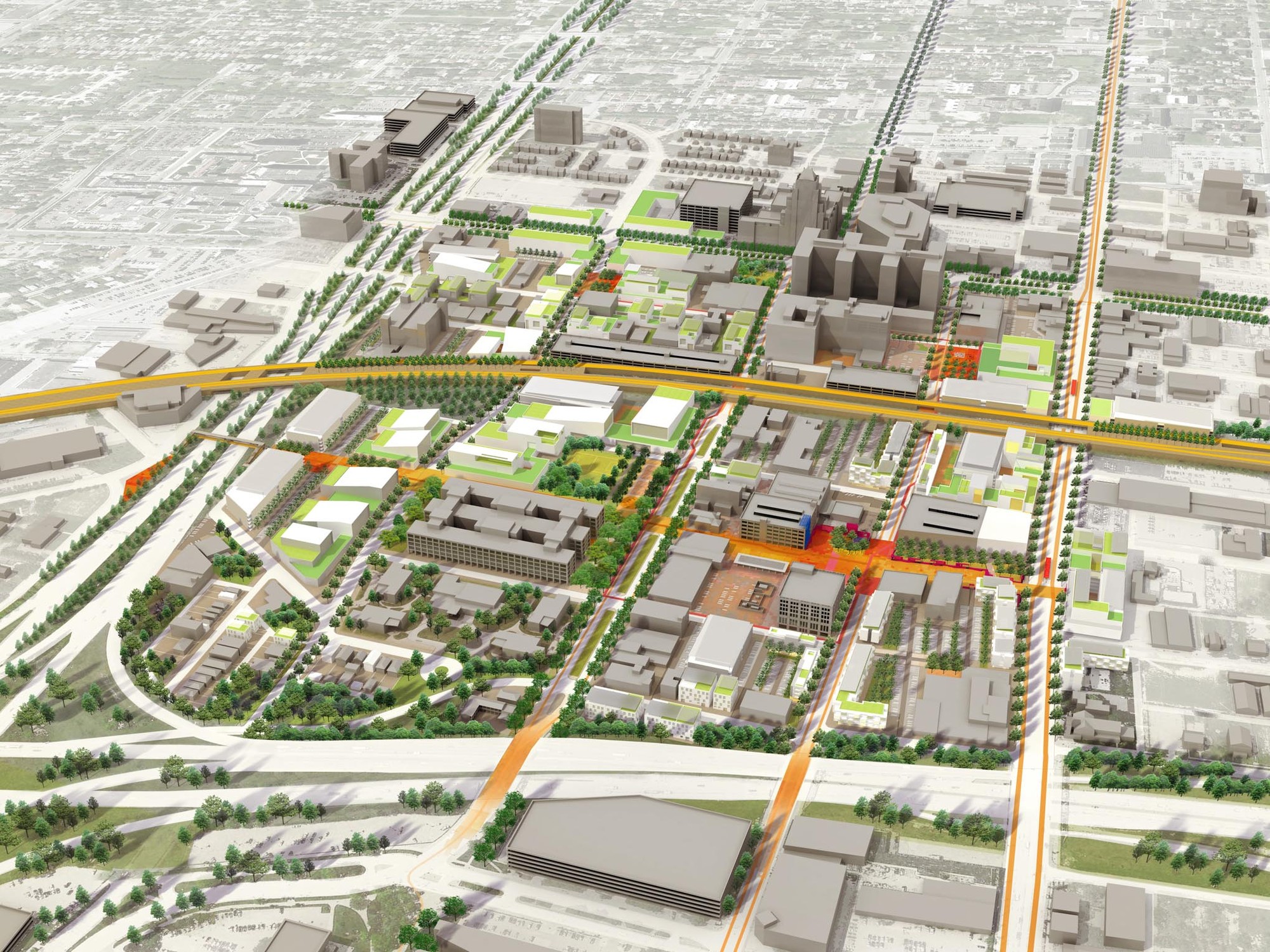
The TechTown District Plan by Sasaki Associates articulates an inspiring vision for the revitalization of the district. An emerging knowledge district in Midtown Detroit, this town is currently characterized by surface parking, vacant properties, and inward-facing, siloed hubs of activity. The architects' concept, however, aims to accelerate innovation, promote entrepreneurship, and build community around the generation of ideas in a vibrant, mixed-use setting. More images and architects' description after the break.

Leveraging the potential of key institutional anchors within the district (Wayne State University, College for Creative Studies, and Henry Ford Health System), the plan creates an environment that fosters knowledge generation and innovation.The plan repurposes the historic building stock with uses that support innovation and create vibrancy, and also strengthens connections within Midtown Detroit and to surrounding neighborhoods.

A key feature of the plan, and an early action item, is a plaza at the heart of the district that contains a variety of program and design elements to foster creativity and the exchange of ideas throughout all seasons, flexible places and spaces for planned and serendipitous gatherings. “Collaboration cubes”—movable, adaptable workstations—can be reconfigured and relocated to meet specific user needs.

The cubes also become icon for the district. Fabrication labs anchor the southern side of the plaza. A projection screen, climbing wall, fire pits, and a café with seating among a grove of trees attract knowledge and creative workers to the heart of the district.The plaza hosts events such as a “maker’s fair” and “hacker challenge” in the summer, while curling lanes and campfires activate the plaza during the winter.

A community park and two additional plazas connected along landscaped corridors provide a range of amenities. This robust public realm framework and urban design strategy transforms parking lots and vacant sites into places for people to come together.

Environmental, economic, and cultural sustainability are foundational elements of the plan. Public open space improvements create a walkable district that reduces demand for parking, and provide access to new lightrail transit. The plan contains an exercise circuit and integrated bicycle network to promote health and wellness. Landscape strategies include bioswales to enhance infiltration and reduce surface run off, while streetscape improvements increase pervious surfaces. The economy of the district focuses on local production of goods and services, and job creation around innovation. The plan preserves the district’s history and character through adaptive reuse of historic buildings.

The team employed a variety of strategies to encourage participation in the TechTown planning process. A regular series of open forums included presentations from experts in innovation districts and research parks, urban design, and planning. Interactive games, such as the “Circuit Board” and the “Coin Survey” allowed the community to test program and design alternatives, and to rank strategies for investment. “MyTechTown”—an interactive online graphic survey—collected constituents’ qualitative impressions of the district, which helped the design team tailor the planning, programming, and urban design strategies.

The vision for TechTown will be realized over time. Initial investments will occur at the heart of the district, beginning with the creation of a pedestrian priority zone that reinforces connections.
Architects: Sasaki Associates
Location: Detroit, Michigan, United States
Sasaki Team: Daniel Kenney, Dennis Pieprz, Philip Perlin, Caitlyn Clauson, Romil Sheth, Alexis Canter, Victor Eskinazi, Liz Juusola, Ponnapa Prakkamkul
Consultants: Blaine Merker, Rebar Group Inc.; Mike Lydon, The Street Plans Collaborative; Anthony Townsend, Institute for the Future; Scott Page, Interface Studio
Client:Midtown Detroit Inc.
Owner’s Advisor: U3 Ventures
Awards: 2013 SCUP Excellence in Planning Merit Award, 2013 BSLA Merit Award
Size: 149 acres
Completion Date: 02/2013
























